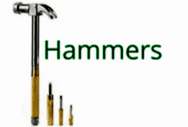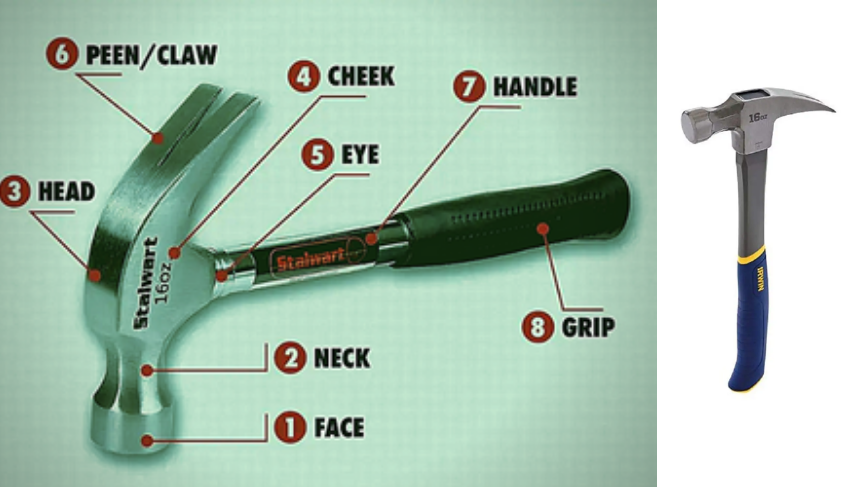You know all the parts of a hammer, right? Hammer head, handle… Sure, you do. But what if someone challenged you to name all the parts?
And worse- what if someone was holding a conversation with you about some types of hammers and the different components?
Would you be able to contribute? If not, don’t panic; this article is designed to help your understanding.
We’ve put together an easy guide to give you a better understanding of the respective parts of the hammer.
Hammer Face

The hammer face is the flat striking face of the hammer. It’s made of metal, usually steel. Steel is an alloy consisting mostly of iron and carbon with small amounts of other elements, including manganese and silicon.
The hammer face can be either flat or slightly curved to provide more surface area for contact with an object being struck by a hammer.
If you’re using a carpenter’s ball peen hammer, it might be curved so that it follows the shape of a woodworker’s mallet head.
However, if you’re using any other type of hammer, such as one for driving nails into wood or concrete surfaces at home repair projects or construction sites then your best bet would be simply getting yourself something like a regular old flat-headed model.
You’ll also want to consider what type of material would best suit your needs: cast steel vs forged steel vs wrought iron vs aluminum alloy).
Hammer Neck

The hammer neck is the thickest part of the hammer body, and it connects the head to the handle.
The neck is also typically where manufacturers place their brand name or logo in order to make sure you know who made your tool. The most common type of material used for this area is cast steel, which isn’t as strong as other types of metal but is relatively cheap and easy to manufacture.
Because it’s so large and exposed on both ends (head and handle), this section is prone to breaking when struck against hard surfaces or when dropped repeatedly onto hard surfaces—which can be very dangerous if it happens while you’re swinging a heavy sledgehammer!
Hammer Head

The head of the hammer is the part that makes contact with the nail. The head is usually made of steel and can be flat, curved, ball-shaped or have any number of other shapes depending on your needs.
Hammer heads also come in a variety of weights (the amount of force required to swing them) and lengths (the distance from one end of the handle to where it joins with the head).
A heavier hammer will do more damage than a light one because it delivers more energy when it strikes something; however, you’ll have less control over where exactly you deliver that blow if your tool weighs too much for you to lift comfortably!
Hammer Cheek

A hammer’s head is made up of two cheeks. The cheeks are the horizontal sides of the head and they’re what you hold when you use a hammer to pound nails into wood. The shape of each cheek is determined by the purpose of the hammer.
For example, if you were working on something that required extra control, like fine carpentry or jewelry-making, you’d want a hammer with a sleek, rounded head.
On the other hand, if your goal was to create lots of force quickly (for example paving bricks), then you’d go with something more angular and flat-faced; this would give you more surface area from which to drive down onto whatever it is that needs driving down onto.
Peen or claw of a hammer

The claw of a hammer is used to pull nails out of wood. The claw has a curved end that can be inserted under the head of a nail. Once the nail is pulled out, the claw can be used to push it out of the way.
The claw can also be used for prying, but it’s not as effective as a flat-head screwdriver or chisel.
If you have several nails sticking up from your work surface, you can use the claw on your hammer to make sure that they’re all flush with your project.
Hammer Eye

The eye is the hole in the head of the hammer. It is used for attaching the handle, and it also helps distribute force evenly throughout the tool.
Hammers used for wood tend to have a neck or shoulder in their face; this prevents them from slipping out of position when hitting nails or driving screws into wood.
Hammers for rock and metal do not usually have these features because they are often better at performing actions such as chipping away at other rocks or metals than finishing work such as putting in nails or screws.
Hammers Handle

The handle is the part of your hammer that you hold while using it. It’s what allows you to grip the tool comfortably and easily.
Materials that are used to make handles are: wood, metal, and plastic. Wood has been used for many years, but in recent times it has been replaced by synthetic materials like fiberglass or carbon fiber because they are stronger and lighter than wood handles.
Hammers Grip

The grip is the rubber slipped around the handle of a hammer. It helps you maintain a solid hold on the tool and prevents vibrations from being felt in your hands. However, not every hammer has a grip, as it is not needed for most applications.
You won’t find one on any type of framing or carpenter’s hammer, but you might find one on smaller hammers like a taker or putty knife.
If you need to make sure that your hand doesn’t slip from fatigue during long projects where maintaining a solid hold on the tool is crucial, then it may be beneficial to look for one with a rubberized grip.
Final Thoughts
While hammers are undoubtedly one of man’s oldest tools, their development and use have evolved significantly over time. Hammers are now available in a variety of shapes, sizes, weights, and materials to best suit the task at hand.
Traditional hammers have evolved into specialty hammers with very specific applications in mind. Each hammer has its own set of parts. You already know a lot about the parts of a hammer from this blog, which will help you be more informed when you rent or buy your next hammer.
Frequently Asked Questions
What are the parts of a hammer called?
The parts of a hammer are the head, the handle, the claw, and the grip. The head is the part of the hammer that strikes the nail, and is usually made of metal. The handle is the part of the hammer that you hold, and is usually made of wood.
The claw is the part of the hammer that is used to pull nails out of wood, and is usually made of metal. The grip is the part of the hammer that you hold onto, and is usually made of rubber.
What are the ends of a hammer called?
The ends of a hammer are called the head and the claw. The head is the heavy, flat end that is used for pounding. The claw is the sharp, curved end that is used for pulling nails out of wood.
What is the best part of a hammer?
There is no definitive answer to this question as it depends on personal preferences. Some people might find the best part of a hammer to be the handle, as it provides a comfortable grip that makes it easy to wield the tool.
Others might prefer the head of the hammer, as it is the part that actually delivers the blow. Ultimately, it is up to the individual to decide what they believe to be the best part of a hammer.
What are the claws of a hammer called?
The claws of a hammer are the two metal prongs that protrude from the head of the tool. These prongs are used to extract nails from wood or other materials.
The shape of the claws varies depending on the type of hammer, but they typically have a curved or V-shaped profile.

